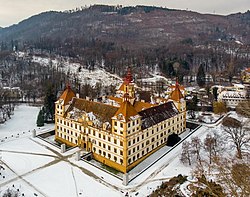
Back Eggenberg Sarayı Azerbaijani Замък Егенберг (Грац) Bulgarian Dvorac Eggenberg BS Castell d'Eggenberg Catalan Eggenberg (zámek) Czech Schloss Eggenberg (Graz) German Palacio de Eggenberg Spanish Eggenbergi loss Estonian Eggenberg jauregia Basque اگنبرگ (کاخ) Persian
| Eggenberg Palace | |
|---|---|
Schloss Eggenberg (in German) | |
 Aerial view in January 2019 | |
 | |
| General information | |
| Type | Palace |
| Architectural style | Gothic and Baroque |
| Location | Graz, Styria, Austria |
| Coordinates | 47°04′26″N 15°23′29″E / 47.07389°N 15.39129°E |
| Elevation | 365 m (1,198 ft) |
| Current tenants | Palace State Rooms, Alte Galerie, Coin Collection, Roman Stonework Collection, Archaeology Collection |
| Construction started | after 1460 (medieval section), 1625 (Baroque expansion) |
| Completed | c. 1635 (structure), 1685 (accouterments), 1762 (piano nobile) |
| Cost | over 105,000 guilder |
| Client | Universalmuseum Joanneum |
| Owner | The State of Styria |
| Height | 50 m (164 ft) (central tower) |
| Dimensions | |
| Diameter | 65 m x 80 m (palace footprint) |
| Other dimensions | 90,000 m² (palace grounds) |
| Technical details | |
| Floor count | 3 |
| Floor area | 8,000 m² |
| Design and construction | |
| Architect(s) | Giovanni Pietro de Pomis |
| Other designers | Hans Adam Weissenkircher (court painter) |
| Official name | City of Graz – Historic Centre and Schloss Eggenberg |
| Type | Cultural |
| Criteria | ii, iv |
| Designated | 1999 (23rd session) |
| Reference no. | 931bis |
| Region | Europe and North America |
| Extensions | 2010 (34th session) included Schloss Eggenberg |
| References | |
| |
Eggenberg Palace (German: Schloss Eggenberg) in Graz, is the most significant Baroque palace complex in the Austrian state of Styria.[1] With its preserved accouterments, the extensive scenic gardens, as well as some special collections from the Universalmuseum Joanneum housed in the palace and surrounding park, Schloss Eggenberg ranks among the most valuable cultural treasures of Austria. Eggenberg Palace is situated at an elevation of 381 meters on the Western edge of the city.[2] Its architectural design and the still visible imprint of centuries of history continue to bear witness to the vicissitude and patronage of the one-time mightiest dynasty in Styria, the House of Eggenberg.
In 2010, the significance of Schloss Eggenberg was recognised with an expansion to the listing of the Graz Historic Old Town among the UNESCO World Cultural Heritage Sites.
Surrounded by walls, with a huge portal facing West, the palace is located in the Eggenberg district of Graz and can be reached by tram. The northern corner of the palace grounds features the Planetary Garden and Lapidarium of Roman stonework as well as the entrance to the new Archeology Museum,[1] which houses the Cult Wagon of Strettweg. At ground level, the palace houses a numismatic collection (Coin Cabinet)[3] located in the former rooms of Balthasar Eggenberger, owner of the imperial minting license and operations in the Late Middle Ages. On the upper level, the Alte Galerie[4] encompasses a large array of paintings, sculptures, and other works of art from the medieval era through the early modern period, spanning five centuries of European art history.
- ^ Das Joanneum – Österreichs Universalmuseum. 2006
- ^ Eggenberg Palace Elevation and Location
- ^ "Coin Cabinet Schloss Eggenberg". Joanneum. Retrieved 6 October 2019.
- ^ "Alte Galerie Schloss Eggenberg". Joanneum. Retrieved 6 October 2019.